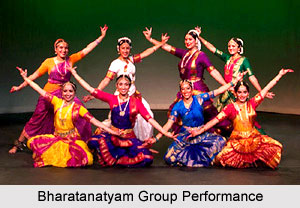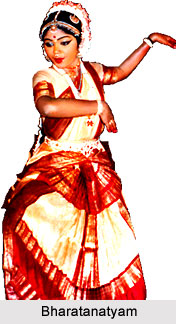 Bharatnatyam originated in Tamil Nadu which is also referred to as artistic yoga and Natya yoga. The name Bharatnatyam is derived from the word "Bharata" and, thus, associated with Natyashastra. Though the style of Bharatnatyam is over two thousand years old, the freshness and richness of its essence persists even today. The technique of human movement which Bharatnatyam follows can be traced back to the 5th century A.D. from sculptural evidence. This classical dance has a mesmerizing effect as it uplifts the dancer and the beholder to a higher level of spiritual consciousness. It is a dancing style that comprises of Bhava, Raga, Tala, and Natya which reflect the real meaning of the Bharatnatyam.
Bharatnatyam originated in Tamil Nadu which is also referred to as artistic yoga and Natya yoga. The name Bharatnatyam is derived from the word "Bharata" and, thus, associated with Natyashastra. Though the style of Bharatnatyam is over two thousand years old, the freshness and richness of its essence persists even today. The technique of human movement which Bharatnatyam follows can be traced back to the 5th century A.D. from sculptural evidence. This classical dance has a mesmerizing effect as it uplifts the dancer and the beholder to a higher level of spiritual consciousness. It is a dancing style that comprises of Bhava, Raga, Tala, and Natya which reflect the real meaning of the Bharatnatyam.Origin of Bharatnatyam
Bharatnatyam has developed in the South and gradually was restricted to what is now known as Tamil Nadu. It is evident from chronicles that the Chola and the Pallava kings were great patrons of the arts. Rajaraja Chola maintained dancers in the temples in his kingdom. The tradition of the Natyashastra is widespread. The origin and tradition of Bharatnatyam is appealing and enlightening. This dance form was nurtured in the temple by the Devadasis, servants of the God. It was taken to the princely courts and the Chola and the Pallava kings were believed to be the great patrons of this art. The contributions of the South Indian saint-poets and musicians cannot be ignored. Bhakti or devotional cult was infused into the tradition by these poets. The literary content of Bharatnatyam was provided by them and their musical compositions determined the repertoire of this dance form. The solo or the sadir nritya is the direct descendant of this tradition. Besides the rich history of Bharatnatyam, another mythological tale is also attached to the origin of this dance. It is believed that Goddess Parvati taught this dance form to Usha, daughter of Banasura, a demon. Usha taught the same to the Gopikas of the city of Dwaraka, birth place of Lord Krishna. This is how the spiritual dance form Bharatnatyam was introduced to the mankind.
Development of Bharatnatyam
The advent of a new era and the continuous experiment in the performing art form acted as a foundation for the recent development in Bharatnatyam. The dance form went through various assessments to gain the present shape. Bharatnatyam Dance has a rich legend to share that acted as a sustaining cause for its prominence. The dance form was codified and documented as a performing art in the 19th century by four brothers who were called the Tanjore Quartet. Chinnayya, Ponniah, Sivanandam and Vadivelu of the Tanjore Court during King Sarabojis rule between 1798 AD-1824AD introduced Bharatnatyam with its various forms such as the Alarippu, Jathiswaram, Sabdham, Varnam, Tillana. The four brothers revised Bharatnatyam into its present shape by introducing various forms like the Alarippu, Jathiswaram, Sabdham, Varnam, Tillana. The dance form was carried from one generation to another and the direct descendants of these four brothers formed the original group of Nattuvanars or dance teachers of Bharatnatyam in Tanjore.

Theme of Bharatnatyam
Bharatnatyam is a solo, feminine type of a dance, which is tender and erotic. The basic theme is love, where the female dancers usually perform as a devotion to the Supreme Being; or love of a mother for child. It epitomizes the adoration of lovers separated and reunited. This dance is considered to be a fire dance, where there is a mysterious display of the abstract element of fire in the human body.
Technique of Bharatnatyam
Among the various styles of Bharatnatyam the Pandanallur and the Vazhuvoor are more significant. Pandanallur style is characterized by its deep sitting positions; its slow Lasya padams, and difficult standing positions. Vazhuvoor is characterized by a static posture to break the monotony with rhythmical variety.
The technique of Bharatnatyam consists of Natya, Nritta and Nritya. Natya is the dramatic art which is the language of gestures, poses and mimes. Nritta includes the rhythmic and repetitive elements. The Nritya is a combination of Nritta and Natya. Abhinaya also is another technique. It is subtle with more spontaneous expressions.
For more, visit the link below: